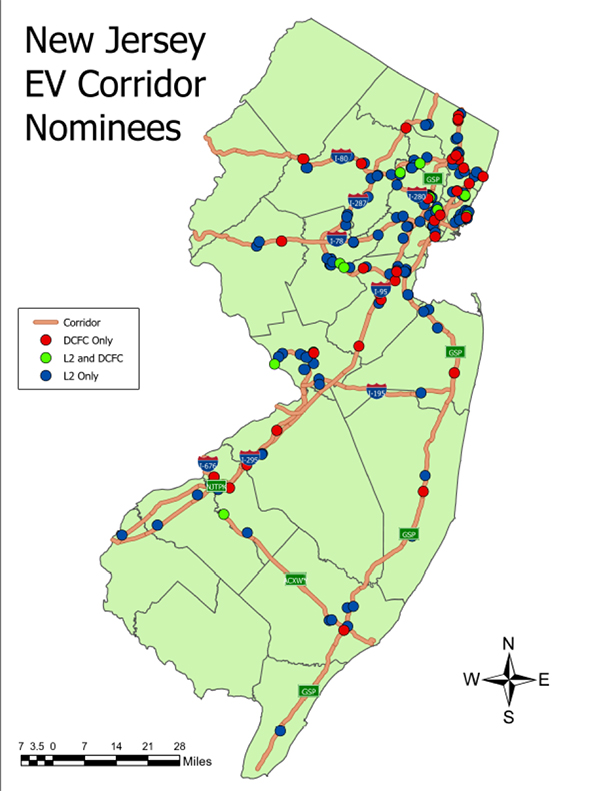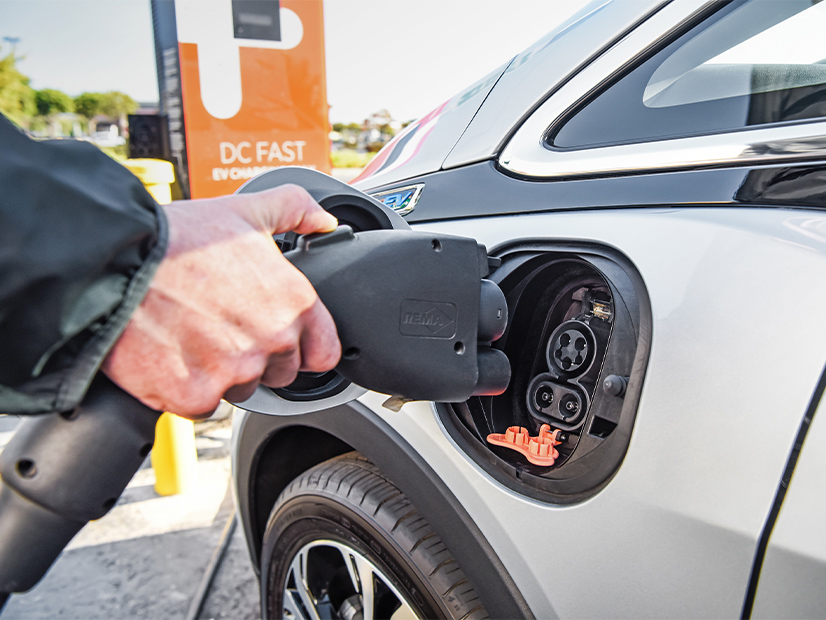New Jersey will spend $10.8 million to fund the purchase of heavy-duty electric vehicles, including 10 electric school buses, and install 62 fast-charging stations that will enhance the charger coverage outlined in the state’s recently filed National Electric Vehicle Infrastructure (NEVI) deployment plan.
The state investment, announced by Gov. Phil Murphy last week, will put charging stations at 31 locations around the state, funded with $3.9 million from New Jersey’s share of the nationwide Volkswagen settlement. Another $6.9 million, drawn from funds awarded to the state under the Regional Greenhouse Gas Initiative (RGGI), will pay for the buses, as well as for seven electric garbage trucks and two buses for non-school use.
The announcement follows the submission just before the Aug. 1 deadline of the state’s NEVI plan to the Federal Highway Administration (FHWA). The plan outlined a three-pronged strategy to “install fast chargers every 50 miles” along certain designated traffic corridors using $104.4 million in FHWA funds awarded to the state.
The state expenditures are designed in part to increase the number of electric trucks and buses that pass through communities overburdened by air pollution, said Shawn LaTourette, commissioner of the New Jersey Department of Environmental Protection (DEP).
“While medium- and heavy-duty vehicles are fewer in number than passenger cars, they contribute a much larger share of emissions per vehicle, so there is a major benefit to the environment when we electrify them,” he said.
The state investment on charging stations — with two chargers per site at 16 locations to be installed by government entities and 15 by private entities — are designed to expand the number of “community fast-charging” stations, LaTourette said. The charging locations were picked on criteria that included locations where people live and work — such as town centers, commercial areas, retail centers and concentrations of multiunit dwellings (MUDs) — and had to be accessible to the public, open 24/7 and able to accept payment from all credit cards.
The list of charger locations picked to be funded are spread across the state, including at municipal halls, retail stores such as 7-Eleven, car dealerships and a church. The grants ranged from a maximum of $75,000 for a 50-kW charger, to $200,000 for a charger of 150 kW or greater.
In a release outlining the $10.8 million expenditure, Murphy’s office said that locations that were considered for state funding but were eventually rejected will now be considered for funding under the NEVI plan.
Charging Stations Every 25 to 50 Miles
States were required to submit their NEVI plans by Aug. 1, detailing how they would site a charging station every 50 miles on major interstate routes in order to receive federal funds. The FHWA now has until Sept. 30 to review and approve the plans.
 New Jersey’s DC fast chargers and L2 chargers currently within one mile of the state’s designated alternative fuel corridors. | New Jersey Department of Transportation
New Jersey’s DC fast chargers and L2 chargers currently within one mile of the state’s designated alternative fuel corridors. | New Jersey Department of Transportation
The rules also required fast chargers to be available 24/7, operating 97% of the time and able to accept any debit or credit card. The program also requires states to contribute 20% of the cost of building out the charging stations on highways designated Alternative Fueling Corridors (AFCs). (See States File Plans on Deadline for Federal EV Charging Funds.)
Pamela Frank, CEO of ChargEVC, a trade and research organization that promotes EV use, said New Jersey had done a “reasonably decent” job on the NEVI submission and in keeping a strong focus on ensuring that the key arteries through the state have EV charger coverage.
“This plan does not dot every ‘i’ and cross every ‘t,’ but I think it hits on” the key points, she said. That was assisted by the fact that New Jersey’s 2020 EV law addressed much of the same ground but with some more stringent measures, requiring a charging station every 25 miles on certain highways instead of the 50 miles under the federal program.
“New Jersey’s law says ensure coverage so that nobody ever has to go anywhere without bumping into one of these fast-charging opportunities every 25 miles,” Frank said. “Every 50 miles doesn’t cut the mustard,” but “the good news is federal dollars are going to help us get to our buildout that was mandated under New Jersey law faster. So it’s like they’re feeding each other. It’s more money to help New Jersey get to the very ambitious goals it has.”
Aiming for Statewide Coverage
Under the first phase of the state’s NEVI plan, from 2022 to 2024, New Jersey officials would designate 12 highways in the state as AFCs, among them the New Jersey Turnpike and Garden State Parkway. The state would also use the funds to install four 150-kW chargers at least every 50 miles at locations less than a mile from the highway exit.
The second phase, from 2023 to 2025, would focus on adding to those charger stations with a goal of installing chargers every 25 miles. In some cases, the state would look to increase funding efficiency by placing a charger at an intersection that serves two corridors, according to the plan.
The final phase, through 2026, would involve the installation of chargers that address other charging needs in the state. These would include placement in certain “community-centric” locations, putting chargers near MUDs and locating sites in overburdened and disadvantaged communities where they can serve ride-sharing and ride-hailing programs. The New Jersey Board of Public Utilities (BPU) recently identified this as key to helping speed the uptake of EVs in disadvantaged areas where economic circumstances and obstacles to owning an EV would otherwise hinder the adoption of the vehicles. (See NJ Study Looks at Getting EVs into Overburdened Communities.)
The effort to cover the state with EV chargers is part of a portfolio of programs aimed at helping the state meet the goals set out in the Energy Master Plan for the state to deploy 330,000 light-duty EVs on the road by 2025. The NEVI plan said the state had 126 DCFC sites in 2022, and it would need 1,600 to 5,600 in 2035 to meet the goal of plug-in EVs accounting for all vehicle sales in the state.



